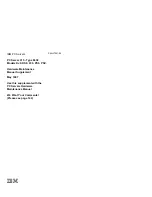
hardware
The physical components—mechanical and electrical—that make up a system.
Compare to software.
head
The part of a fixed disk drive, diskette drive, or tape drive that reads, records,
and erases data. Also called read/write head.
icon
A graphic symbol that visually represents a device or a procedure’s function.
IEEE
Institute of Electrical and Electronics Engineers.
input/output (I/O) device
A piece of equipment that accepts data for transmission to (input) and from
(output) the system. For example, a terminal.
I/O
Input/output. See input/output (I/O) device.
LAT
Local area transport. The LAT is a communications protocol that implements
terminal emulation over an Ethernet local area network. Terminals are
normally connected to terminal servers, which send messages containing
terminal data to host systems. The host systems view the remote terminal as
if it was locally connected to the host.
LED
Light-emitting diode. LEDs are used as indicators on the system enclosure.
link
A communications path between two nodes. A physical link is the electrical
connection between two nodes. A logical link implies that two nodes are able
to communicate whether or not they have a direct physical link.
load
To copy software (usually from a peripheral device) to memory. To physically
place a disk in a disk drive or a tape in a tape drive.
Glossary–6













































